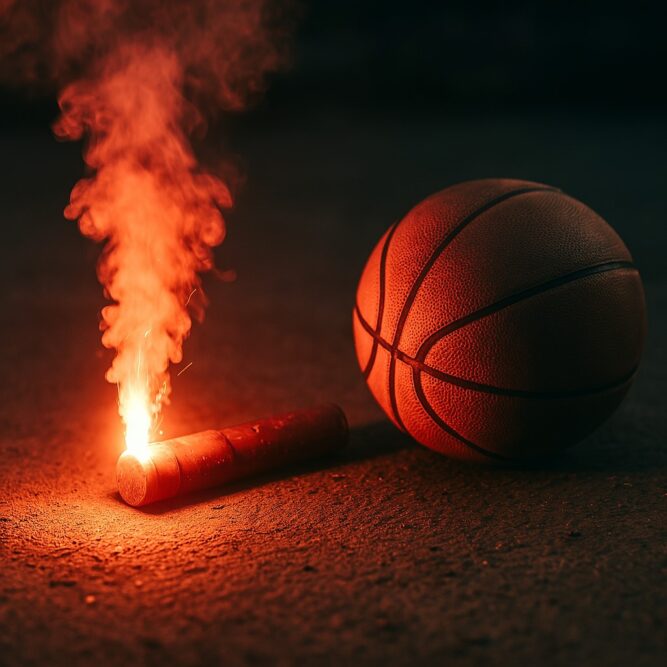
It’s time for the fifth and final part of our series, NBA Europe: The Grand Experiment. This final article on the cultural battle — the emotional, tribal, and unpredictable part of any sports venture. In short, it’s about the fans. The NBA and FIBA may have the branding and the resources, but without fan buy-in, the league risks becoming a shiny product with no soul. With Euroleague, for all its faults, at least having that, will NBA Europe be able to win hearts and minds of the people that actually pay to watch basketball?
Part 1: The High Price of NBA Europe
Part 2: Can NBA Europe take over?
Part 3: Will Europe’s top clubs join NBA Europe?
Part 4: Can NBA Europe win on TV?
NBA Europe can build arenas. It can license logos. What it can’t do is manufacture loyalty. The NBA and FIBA’s biggest challenge might not be media deals or club buy-ins. It might be the basketball fans themselves, many of whom are extremely familiar with the Euroleague product.
Tribalism Runs Deep
Anyone who has experienced the Greek derby or even been to watch an Alba Berlin game gets this aspect. Fans in Europe are loyal to clubs, not leagues. There is a rich link between the clubs, not franchises, and their cities along with the histories and rivalries that run deep. Many of these rivalries, on a cultural level, predate the existence of the USA never mind the creation of basketball.
That is a key thing to bear in mind with fandom in Europe. Fans of Euroleague sides, or really any club in Europe, don’t follow a product. They follow their team and feel it to be an extension of their own culture.
FIBA and the NBA can’t just replicate that out of thin air. For NBA Europe to work, it must find a way to weave these aspects into the product. With a 16 market, initially, semi-closed new league, that’s far from an easy task.
A League Without Legacy
NBA Europe, of course, wants to attract many of the top teams in Euroleague. It also however wants to create new clubs, really franchises, from scratch. The teams it envisions for London, Paris, and Berlin seem to not be tied to existing basketball clubs in those cities. While that may not be an issue in London, it will be in Paris and Berlin. More importantly, the actual legacy clubs that will be on board won’t feel the same connection.
That could mean that fans, even those of teams with lengthy histories, may consider NBA Europe to be manufactured or corporate. The grit, the guts, the occasional actual blood is part of the history of the sport here. It feeds into a tradition that, while disjointed, is important to the core consumer bases FIBA and the NBA want to attract.
Even with the new fans there will be a disconnect. Remember, the NFL failed with NFL Europe because NFL fans in Europe cared for the NFL, not a secondary imitation. When the NFL started bringing real games to Europe, they were an enormous success. That could well prove telling for the NBA. While real NBA games attract enormous interest in Europe, a basketball product with the NBA name but not real NBA teams won’t resonate to the same degree.
BallinEurope is ramping up its YouTube game this season. Subscribe to our channel now for player exclusives, analysis videos, and much more.
Culture Clash
The NBA regular season is, for the most part, a bit of a drag. What all of the existing pan-European competitions have going for them is a real sense of value to regular season games. While Euroleague uses the slogan Every Game Matters, in truth it could just as easily apply to the Basketball Champions League, Eurocup, and the FIBA Europe Cup.
There’s also the culture clash in basketball style. The existing core market expect to see the European style of the game. The new fans that NBA Europe wants will, naturally, expect basketball that looks more like the NBA, albeit with fewer ad breaks.
This culture clash is not easy to manage and finding a satisfactory middle that keeps all consumers happy, looks like a nightmarish challenge. It’s also one that FIBA and the NBA simply must succeed in meeting in order for the product to be a success.
BallinEurope has a book, a real life actual book called I Like it Loud, and you can buy it on Amazon now. It’s here as a book and here in Kindle form.
What It Takes to Win Fans
The first thing is for everyone in the NBA to realise that while FIBA’s executives all speak perfect English, frankly better than mine in most cases, that’s not the norm. Hyperlocalisation is simply mandatory. That means extensive investment in each individual market to build storytelling in local languages, using familiar commentators with knowledge of the game, and recognising the rich and complex history of the clubs and their rivalries.
This will require respecting the existing basketball culture in Europe, even in cities where it may look challenging to succeed financially. The total product relies on the legitimacy having strong presences in Athens, Belgrade, and Kaunas. They may not be revenue positive individually (although the Athens clubs have proven they can be) but they are vital for the total product to be profitable.
Finally, the one thing about Euroleague that NBA Europe simply must succeed at is authenticity. It’s got to be real. This may be a new product in the basketball market but it has to show it’s not simply a lesser copy of the NBA. This means winning fans one city at a time to prove it isn’t a gimmick.
You’d think that would be all there is to say after five articles. The story, of course, keeps evolving. There’ll be a video next week on our YouTube.
The NBA and FIBA plan on launching a European league in 2026 — but can it really work? In this five-part series, we dive into the financial gamble, the structural chaos, the club politics, the media game, and the cultural fight for basketball’s soul. From billion-dollar ambitions to legal landmines and fan resistance, NBA Europe: The Grand Experiment breaks down the biggest shake-up in European hoops in decades.




Leave a Reply